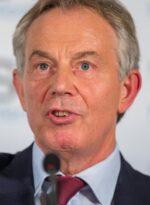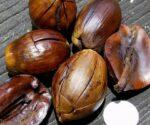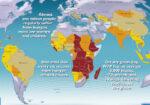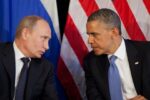How to Change the World – Greenpeace
In 1971 a brave group of young activists set sail from Vancouver in an old fishing boat. Their mission: to stop Nixon’s atomic bomb tests in Amchitka, a tiny island off the west coast of Alaska. It was from these humble but courageous beginnings that the global organisation that we now know as Greenpeace was born. Chronicling the fascinating untold story behind the modern environmental movement, this gripping new film tells the story of eco-hero Robert Hunter and how he, alongside a group of like-minded and idealistic young friends in the ’70s, would be instrumental in altering the way we now look at the world and our place within it.

Tony Abbott went to London and at a dinner suggested that Europe stop the refugees coming in. But more of that later. Tony Blair held a press conference before the release of the Chilcot Report so he wouldn’t appear to be such a bad guy over the disintegration of the Middle East. He is a war criminal waiting to happen and George W Bush and maybe John Howard won’t be far behind. Even The Donald, one of the most pompous and awe-deflating Republican presidential candidates the world has ever seen, gets it. He said recently that Saddam Hussein and Muammar Gaddafi ought to be still alive and we wouldn’t be in such a mess. The Donald said what we are all thinking and not expressing enough. The USA and its allies have made a pretty big mess and don’t know how to get out of it. Vladimir Putin is becoming a folk hero in Syria as he goes about his business of getting rid of Isis in a steady, let’s bomb them now kind of a way. And Isis…well they wouldn’t be about if the west had left the Middle East alone all those years ago. It’s a big mess and it’s going to be awfully hard to fix it. War creates pain and right now thousands and thousands of refugees are trying to find some peace in faraway fields in Europe. Back to Tony Blair…in the UK officials want him to stand trial for his role in all this. Anger abounds and the Chilcot Report may well be the mechanism to make this happen. Tony Abbott is telling Europe to do what Australia did…turn the people back…protect your borders and let Assad and all his mates look after their own people. –The Elephant in the Conversation

Global convening to explore how bold new climate approaches and impactful solutions can help achieve a better world. New York (Oct. 27, 2015) – Earth To Paris, a coalition of partners helping to drive awareness about the connection between people and planet as well as the need for strong climate action, announced it will host “Earth To Paris—Le Hub” a two-day, high-impact, live-streamed summit on 7 and 8 December in Paris during COP21 — the United Nations climate conference to deliver a new universal climate change agreement. Earth To Paris—Le Hub will provide the opportunity for cross-sector, solutions-oriented engagement in climate change conversations around COP21; a platform for amplifying the conversation across social and digital media; and series of activations through inspiring calls to take bold, meaningful action to address climate change. Experts, advocates, CEOs, and other leaders in Paris will discuss creative and impactful solutions to climate change, while participants around the world take part through multi-language livestreamed video and real-time interactions across multiple social media platforms using the unifying hashtag #EarthToParis. A unique mix of speakers will share their visions for the future. The first tranche of speakers– with more to come–includes: • Anne Hidalgo, Mayor of Paris • Helen Clark, Administrator, United Nations Development Programme (UNDP) • Anthony Lake, Executive Director, UNICEF • Irina Bokova, Director-General, UNESCO • Dr. Gro Harlem Brundtland, Former Prime Minister of Norway; Special Envoy, United Nations; Deputy Chair, The Elders; Board Member, United Nations Foundation • Esther Agbarakwe, Digital story-teller and +SocialGood Advisor • Dr. Paul Bunje, Senior Director of Oceans, XPRIZE Foundation • Kathy Calvin, President and CEO, United Nations Foundation • Rocky Dawuni, Singer, songwriter, Ambassador for United Nations Foundation-hosted Global Alliance for Clean Cookstoves • Dr. Sylvia Earle, Marine biologist and National Geographic Explorer-in-Residence • Andrew Freedman, Science editor, […]

A study, by Dr Girish Chandra Pant of the Indian Council of Forestry Research and Education, assessed the present and future resource potential of Sal seeds, existing market mechanisms and their role in livelihood generation for rural communities in India. The Sal tree, Shorea robusta, is an evergreen species native to India, Myanmar and Nepal. Sal seeds are an important non timber forest product and source of income for about 90,000 forest fringe villages with a combined population of 56 million. The Sal seed is prized mainly for its oil, which has significant potential for export markets due to its low price. During the months of May and June, many rural people in central, eastern and northern India collect the seeds in order to supplement their incomes until the agricultural season begins. “There is an urgent need to attract villagers to Sal seed collection work, fix the procurement rates at a level that allows at least a minimum wage to be collected by the collectors, assess the sustainable harvesting levels and practices to ensure timely processing of the seeds to preserve their quality, and increase awareness among collectors to avoid the use of unhygienic sacks and pesticides for storing kernels,” states Dr Pant. Based on his investigation of Sal seed collection activities at three sites in Uttarakhand state in northern India, the author recommends that clear-cut guidelines be set for estimating collection quantities so that planning for collection and marketing can be prepared accordingly. In addition, “the government should review the decision to ban Sal seed collection in Kumaun and allow the use of Sal fat in food items such as chocolates and ice creams,” he concludes. The current ban on collecting Sal seeds in Kumaun was imposed to improve the regeneration of Sal trees in this region. –gcpant10@yahoo.com; […]

Malta attracts IT professionals and Norway entices with its favorable work-life balance, while expats in Luxembourg enjoy excellent job security Munich — In its latest global survey about expat living, InterNations, the world’s leading social network and information site for people who live and work abroad, presents Malta, Norway and Luxembourg as ideal destinations for those who are looking for a job abroad. Expats in Italy, Portugal and Greece, on the other hand, are lacking promising career choices and job security. Moreover, expats in Greece are suffering from a bad work-life balance. From a global perspective, it is expats over 50 who are happiest with their work life, closely followed by workers in their early thirties. Best and Worst Career Destinations Malta ranks first in the Expat Insider 2015 survey for overall job satisfaction, with seven in ten expats generally satisfied and 27 percent even completely satisfied, compared to a global average of only 16 percent. In terms of career prospects, only the USA and the United Kingdom rank higher. Other popular destinations for those in the search of an interesting job and good career opportunities are China, Mozambique, Luxembourg and Poland. The lower end of the Job & Career ranking is dominated by European countries: Out of 64 countries overall, Italy, Portugal and Greece — all of them suffering economically — offer the least favorable job opportunities for foreign residents. Work-Life Balance around the World Sweden, Norway and Malta occupy the top ranks when it comes to work-life balance, while Saudi Arabia, India and Kuwait are at the bottom. Expats in Sweden, Norway and Denmark, as well as Malta, are also the most satisfied with their working hours, whilst those in Turkey, Greece, and Chile are the least happy with this aspect. Founder and Co-CEO of InterNations Malte Zeeck […]

Rotary will honor six women – all members of Rotary clubs across the globe – at its “Rotary Day at the United Nations” event on November 7. Rotary’s ‘Global Women of Action’ will be recognised for donating their time, talents and expertise towards helping thousands of people in need throughout the world. Since the volunteer service organisation’s founding more than 100 years ago, Rotary has harnessed the strength of professional and community leaders to tackle humanitarian challenges at home and abroad. Today, Rotary provides a platform for successful men and women of all ethnicities, faiths and cultures to make the world a better place through volunteer service. Rotary’s ‘Global Women of Action’ are: Kerstin Jeska-Thorwart, Nuremberg, Germany: A member of the Rotary Club of Nurnberg-Sigena, Jeska-Thorwart is the creator of the “Baby Hospital Galle” project, which she launched after surviving the devastation of the 2004 tsunami in Sri Lanka. With a budget of USD 1.8 million and the support of 200 Rotary clubs and 6,000 members, the project rebuilt and equipped the Mahamodara Teaching Hospital in Galle, Sri Lanka. In the 11 years since its inception, the project has helped more than 150,000 children and provided healthcare services to more than 2.2 million women. Dr. Hashrat A. Begum, Dhaka, Bangladesh: A member of the Rotary Club of Dhaka North West, Begum has been at the forefront of the women’s health in Bangladesh, implementing several large scale projects to deliver health care to underserved communities. She works to organize free weekend clinics for slum dwellers, providing vocational training to girls who have dropped out of school, empowering women to earn livelihoods as seamstresses, and working to raise awareness of social and health issues among young people. Begum also works to fund a clinic for the people of Washpur, a densely populated […]

The world has faced food crises twice since the latter half of the 20th century. The first one took place in 1973. The world end of term grain stock ratio, which had been on the decline for some years because of the worldwide grain failure, sank to a record-low of 15.4% in 1972. In the same year, the Soviet Union became a net-importer of grain due to the increase of livestock products consumed by the Soviet people. The 1973 crisis was caused by factors such as the bulk purchase of grain by the Soviet Union under the circumstances of poor harvest, and the U.S. placed an embargo on soybeans, albeit for a short period of time. The impact was so enormous that they named it the Reappearance of the Ghost of Malthus, and grain was referred to as the third strategic material behind nuclear weapons and oil. After that, however, countries including the European Community (EC) steered toward the enhancement of agricultural production, which considerably alleviated the condition of grain supply and demand. While protecting national borders by levying import surtaxes under the Common Agricultural Policy, the EC protected intraregional agriculture through generous support for farm product prices. As a result, they were plagued by excess produce in the 1980s. The EC implemented the raw milk quota system in 1984, and the U.S. also undertook the set-aside. The world grain market substantially shifted to the tone of excesses. The EC, which had failed to eliminate such excess, exported excess agricultural products to developing countries with export subsidies, and the U.S. used the said subsidies in defiance, causing a dumping battle with financial burdens. The agricultural negotiations in the Uruguay Round of GATT started in 1986 under the theme of removing the market distortion through agricultural protection by such developed countries, […]

Russia has moved into Syria and America doesn’t like it. What’s not to like? The United States has been controlling the Middle East and restricting the power of other allied nations. Now Russia is seeing a role for itself in the conflict and whether by stealth or compassion is most certainly making itself felt. They have put America on the back foot. America, currently is not on the front foot. The history of these two superpowers in the Middle East is long and awfully complex. Russia couldn’t make it work in Afghanistan and then America came along and didn’t do very well at all. America went a lot further and really helped in the Arab Spring and a total stuff up of the life of millions of people some – who lived – are desperately finding refuge in Europe. What interest me is the pose of Barack Obama. He meets with Vladimir Putin at the United Nations overnight and is cold, staunch, serious…and quite frankly, looks really boring. What is he trying to prove with his demeanour? Obama came to office as an open and friendly president who promised much for his people but has ended up as a bit of a grouch. He is not on top of his game and he is dealing with both houses being controlled by the republicans. Putin looks compassionately at Obama as he does to someone with a head cold or an attack of appendicitis. He isn’t that bothered by the withering stare or the cold energy when they are together. He knows why he is in New York, gives his address, makes his point and goes back home. Back to Syria. The Russians have to be careful. They are seen to be backing Assad and their ground troops and jets need to […]

How a Think Tank is Tackling India’s Energy Crisis India is the second most populous country in the world with 1.37 billion inhabitants and a population growth rate of 1.58%. By 2030, India is expected to add another 160 million people to the count. Simultaneously, the nation’s economy is growing so rapidly that it recently surpassed China as the world’s fastest growing large economy. To meet the demands of booming business and a growing population, India has turned increasingly towards imported oil, coal, and natural gas. Without a proper energy strategy, this swelling South Asian nation is headed straight for environmental and energy disaster. Load blackouts and shortages are a daily occurrence in India as energy demands skyrocket to meet the needs of industry and the population. Seventy percent of India’s oil is imported and their coal resources are depleting fast. If India hopes to meet these increasing demands, they must tap into their clean and renewable energy potential. Fortunately, the Center for Study of Science, Technology, and Policy (CSTEP) is working to ensure India’s renewable energy future, and to leave no Indian household behind, by conducting evidence-based research to provide suggested solutions to policy makers. CSTEP is an Indian not-for-profit research organisation and one of South Asia’s largest Think Tanks. They are a crucial player in securing wind and solar energy in India. Today, India has installed between 3 and 4 GW of solar and 20 GW of wind power. Prime Minister Narendra Modi has committed to a renewable energy target of 175 GW of renewables by 2022; an ambitious goal that, if achieved, will meet India’s energy needs sustainably, while also creating new job opportunities for the projected 1.6 billion people to inhabit India in 2030. CSTEP continues to provide the Government of India with focused research on […]